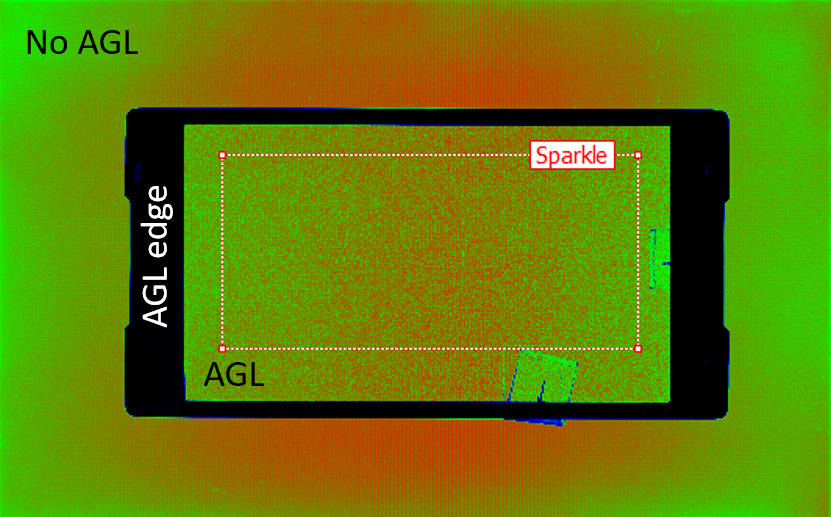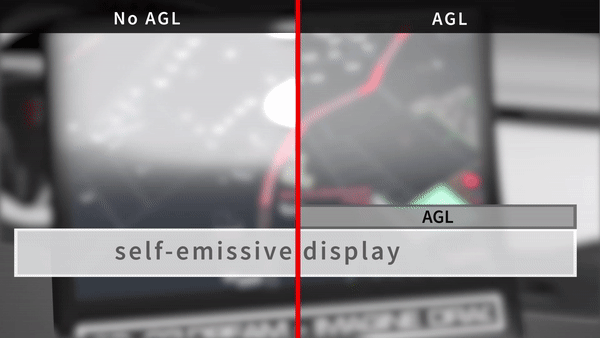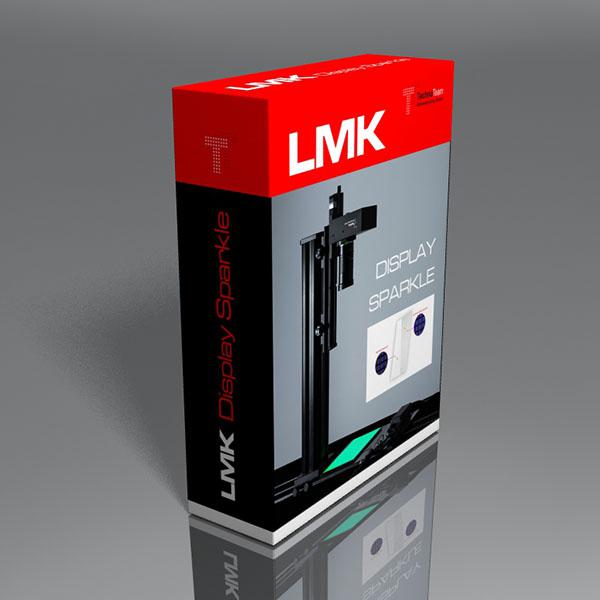Display with AGL (anti-glare-layer)
Reproducible quantification of display sparkle
Application Note – Reproducible quantification of display sparkle
This page shows a summary of the application note. Topic of the document is the measurement of anti-glare-layer-caused display sparkle in a reproducible manner for automotive applications.

What is display sparkle and how is it caused?
Displays used in outdoor applications, for example, automotive displays, are often equipped with anti-glare-layers (AGL), which scatter a large part of incoming light (e.g., sunlight) to enhance contrast. However, they also affect the transmitted part of the light, resulting in a high-frequency water-droplet-like luminance and chromaticity non-uniformity. This phenomenon is called sparkle.
Manufacturers and assemblers of displays are interested in characterizing displays, including the level of perceived sparkle. To this end, TechnoTeam introduces a measurement solution using our LMK camera systems such that the measurements:
- show a high correlation to the sparkle perceived by humans
- are absolute and reproducible for many different LMK camera systems
- enable flexible setups, including BlackMURA-compliant setups
- can be performed without removing the AGL

Visualization of how sparkle is caused
Measurement of display sparkle
To measure display sparkle, you must first align the camera relative to the display, and then you must set up the correct focus, and finally, perform the actual measurements.
The alignment is done using the established BlackMURA pattern for the geometrical setup. This way, the same setup can be used for sparkle and BlackMURA measurements.
One of the more critical points of the measurement setup is finding the correct focus, as undefined blurring of the sparkle pattern negatively impacts reproducibility. To alleviate this problem with both manual and autofocus lenses, we developed the distance focus scan, which changes the distance to the display and, thus, the relative focus position.
The actual measurement is based on a frequency filter approach that analyses the captured image and suppresses only the main frequency from the periodic pixel pattern. This makes it possible to quantize the sparkle in percentage by calculating the sparkle contrast, defined as the standard deviation of the luminance divided by the mean of the luminance.

Distance focus scan
Reproducibility
This method for measuring sparkle is reproducible and can be used with many different camera-lens combinations from TechnoTeam.

Measured sparkle results.
The x-axis of the graph shows the perceived sparkle by humans, which was rated by OEM and Tier 1 experts from the automotive industry.
The y-axis shows the measured sparkle in the specific camera lens setup.
Results
The results are given in percent. The reproducibility of this method makes it possible to use an agreed-upon threshold value for the sparkle. As there is no need to remove the AGL for the measurement, this method can be used at various stages of the development, production and implementation of displays.
Summary
This Application note showed how to measure display sparkle, a high-frequency water-droplet-like luminance and chromaticity non-uniformity caused by using anti-glare-layers. This technique is highly reproducible, correlates well to sparkle perceived by humans, can be used in a BlackMURA-compliant setup and can be performed without removing the AGL.
Download
References
| [1] | Becker M. E., Sparkle measurement revisited: A closerlook at the details, J. Soc Inf. Disp. 23 (10), (2015) |
| [2] | Becker M. E., 8-1: Standardization of Sparkle Measurement: A Solid Basis, SID Symposium Digest of Technical Papers, 49, 1, (2018). |
| [3] | I. Rotscholl, J. Rasmussen, C. Rickers et. al, Understanding and Achieving Reproducibility for the Evaluation of Display Sparkle Contrast, Proc. International Conference on Display Technology 2020, (2020) |
| [4] | I. Rotscholl, J. Rasmussen, C. Rickers et. al, Understanding and Achieving Reproducible Sparkle Measurements for an automotive specification, Proc. SID Vehicle Display 2020, (2020) |
| [5] | Kurashige M. et. al, VHF1-3 Estimation of Equivalent Conditions for Display Sparkle Measurement, Proc. International Display Workshop (2019) |
| [6] | Isshiki M., Inouye A., Tamada M., Kobayashi Y, 78‐3: The Optimized Condition for Display Sparkle Contrast Measurement of Anti‐Glare Cover Glass based on the Solid Understandings, SID Symposium Digest of Technical Papers, 50, 1, (2019) |
| [7] |
German Automotive OEM Work Group Displays, Uniformity Measurement Standard for Displays V1.3, (2018) |
